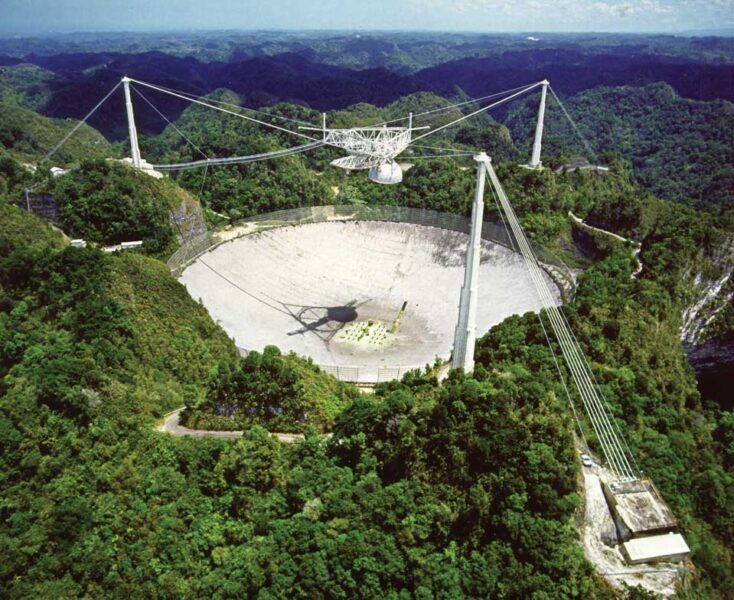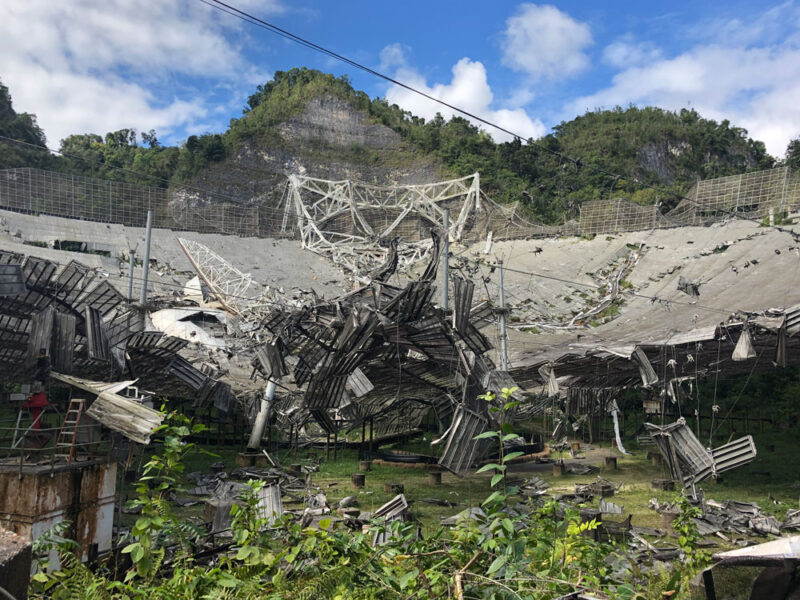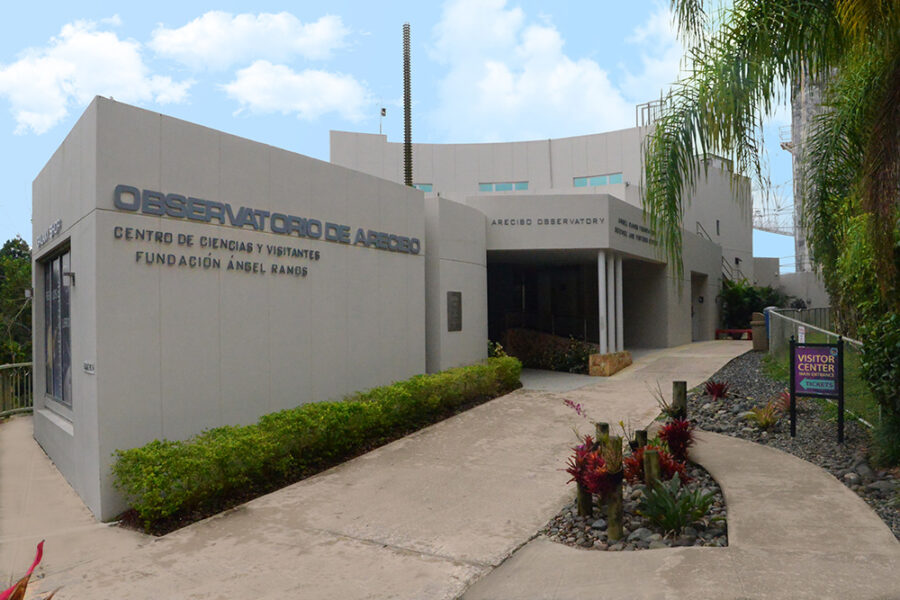While the NSF plans to establish an educational center at the Arecibo Observatory, the institution has stated it will not fund science there.

Arecibo Observatory / NSF
When the National Science Foundation announced the establishment of a new educational center at Arecibo in Puerto Rico, the statement sent shock waves through the astronomical community for what the institution would not support.
From the statement itself, “The solicitation does not include rebuilding the 305-meter telescope or operational support for current scientific infrastructure, such as the 12-meter radio telescope or Lidar facility.” Scientists have programs running currently that use the 12-meter dish to study space weather and the Lidar facility to study Earth’s upper atmosphere.
The National Science Foundation (NSF) has been the steward of Arecibo Observatory since its construction was completed nearly 60 years ago, in 1963. In more recent decades, funding struggles have plagued the facility, but ultimately new partners emerged to manage operations.

Michelle Negron, National Science Foundation
Then the iconic 305-meter dish at the observatory's heart collapsed at the end of 2020. Even though the community rallied with ideas for a replacement, it was clear it would be many years in the making. The contract of the most recent facility manager, the University of Central Florida (UCF), was already set to expire at the end of March 2023 with no clear plans for the future.
Now, the recent NSF announcement puts the writing on the wall.

Roshi et al. / arXiv
“We're entering a transition phase to ramp down scientific and technical activities and hand over to the future STEM education center managers,” says Julie Brisset, who directs the Florida Space Institute at UCF.
What the new education center would look like is still unclear: NSF is soliciting proposals for programs, due in December, so exactly who would manage the new facility is still up in the air. The center would supplement significant education and outreach programs already happening at the observatory.
With the NSF call for proposals for the STEM education center released just last week, time is short. Brisset told Sky & Telescope that NSF has indicated they could extend UCF’s contract (and thus the transition period) until the fall of next year. And despite the lack of support for the existing facilities, it’s still up in the air whether the observatory could continue operations in some form. “I'm pretty sure they would not disregard the opportunity to have science going on — they're just not going to fund it,” Brisset says.

Arecibo Observatory
In fact, the NSF announcement states, “Teams seeking to utilize existing scientific infrastructure or proposing for new projects can submit proposals that are complementary to the scope of the new center.” An NSF spokesperson confirmed that such proposals would be coordinated with NSF and the new managers of the reimagined center.
But the instruments are fragile: To be used for science, they must be taken care of. “If there's, say, one month or so when it's not used and maintained, then usually it doesn't work when you show up again,” Brisset notes.
Community Reaction
The NSF announcement came as a shock to many in the community. Tracy Becker, now at Southwest Research Institute, got her start in planetary science via the Research Experience for Undergraduates program at Arecibo. “I was not expecting the NSF announcement,” Becker says. “Like many other scientists, I have always remained optimistic that the gravitas of the iconic telescope, plus the incredible and diverse scientific research being conducting there and could be conducted there in the future with a modest investment, would be enough to warrant rebuilding the telescope.”

NASA / Arecibo
Becker still works with radar data taken by Arecibo; archived in NASA’s Planetary Data System, that data will remain available even if operations close down. But she notes that many of the computational programs developed to interpret this data — for example, to extract an asteroid’s shape from radar imagery — was developed to work on Arecibo’s own computer systems. “It may become more difficult than it currently is to conduct our research if the site is converted to a STEM education center,” she says.
There also remains the question of replacing Arecibo’s radar capabilities: No existing facility matches what Arecibo could do in terms of characterizing near-Earth asteroids, though it's possible that some capabilities can be recovered through additional investments in existing facilities. NSF reports that it has engaged NASA and other federal agency partners to explore next-generation ground-based radar needs in FY 2022. It expects to have more information to report on this effort in mid-FY 2023.
But perhaps the biggest impact will likely be on the community in Puerto Rico. “To me, there is irony in creating a STEM education center in Puerto Rico through the closure one of the largest facilities on the island that actually employs people with STEM careers,” Becker says. “The engineers and scientists who operate the Arecibo Observatory instruments will need to look for different jobs and many will likely be driven to leave the island of Puerto Rico.”
Brisset agrees. “This is a big loss for the Puerto Rican community,” she says. “I mean, it's great to have a STEM education center there, but a STEM education center always benefits from active science.”
 7
7









Comments
Brett C
October 22, 2022 at 2:18 am
RIP Arecibo. You were awesome.
You must be logged in to post a comment.
Tapasi Ghosh
October 23, 2022 at 4:16 pm
This decision is shocking! The site still contains many valuable equipment, that are used by scientists and students in three major areas of research. This closer of the Observatory will end any possibility of future research activities at the world-class level in the relevant fields on the islands. In fact the very viability of just a proposed STEM center itself could be questioned without the backdrop of a strong, active research organization at the heart of it. This is despite the recent bipartisan (US) senatorial support that was issued in Feb 2022.
This is not quite what Senator Warren had in mind when he said, " “This resolution paves the way for us to explore how to replace and expand on the scientific capabilities of the Arecibo Observatory telescope for future generations.”
Sen Menendez said, “The scientific, cultural, and educational importance of the Arecibo Observatory cannot be overstated. I’m pleased the Senate has adopted this resolution, highlighting the immense contributions of this historic landmark and center. When the observatory collapsed in 2020, we engaged with the National Science Foundation (NSF) to monitor developments. We will continue to push for rebuilding the observatory and further investing in scientific innovation in Puerto Rico."
The press release of that resolution s at this link:
https://www.murphy.senate.gov/newsroom/press-releases/bipartisan-group-of-senators-applauds-passage-of-resolution-recognizing-significant-contributions-of-the-arecibo-telescope
You must be logged in to post a comment.
Tapasi Ghosh
October 23, 2022 at 4:35 pm
Sorry for the typos above (unable to edit, it seems). In particular, I meant "closure" and not "closer" at the start of the second sentence.
You must be logged in to post a comment.
Anthony Barreiro
October 25, 2022 at 4:18 pm
Also, Senator Elizabeth Warren uses "she her hers" pronouns.
You must be logged in to post a comment.
Martian-Bachelor
October 23, 2022 at 9:10 pm
So much for "build back better". This sucks.
You must be logged in to post a comment.
Joanna Rankin
October 24, 2022 at 10:06 am
The Arecibo Observatory must be rebuilt if the U.S. is to regain world leadership in the vital atmospheric sciences, and radar and radio astronomy. As a single example, no instrument in the world has the capacity for detailed imaging of asteroids like Phaethon, whose orbit was revealed on October 17 based on Arecibo observations. According to NASA, it is only one 2,000 “potentially dangerous” asteroids.
The CHIPS Act “encouraged” NSF to strengthen and expand the Observatory’s role, not cut it past the bone, and gut its scientific mission. Congress intended “education, outreach and diversity programs” but also emphasized “future research capabilities and technology at the site.” NSF ignored that, and will only fund such dabs of research as fit in with the STEM center. But the heart of Arecibo’s success with students is their chance to experience it first hand in a real research environment, not just a classroom.
Apart from that, American scientists have had no choice but to use the Chinese FAST Telescope for projects requiring a single dish. It has some of Arecibo’s capabilities, but it has no radar capability at all, and lacks Arecibo’s range of frequencies. Do we really want our data on critical matters such as planetary security from asteroids in Chinese hands?
Arecibo’s STEM programs have touched tens of thousands of Puerto Rican and other students already, from grade school to post doctoral candidates. Of course NSF should continue and expand these successes– with much more than the measly $1 million per year that the current solicitation provides for. But education cannot stand alone.
To cut out the primary science mission at Arecibo is to remove its heart. The richest country in the world needs to step up and rebuild its most famous radio telescope, and reclaim our leadership in this part of the space race.
You must be logged in to post a comment.
Scott
October 28, 2022 at 11:19 pm
Arecibo was clearly one of the great endeavors of human history. It provided singular capabilities enabling astronomers to advance scientific knowledge immeasurably. In recent years, however, it also clearly reached an inflection point in its ability to enable further major advances, as underscored by the difficulties in continued funding, and ultimately punctuated by the final collapse of the infrastructure. Although disappointing from a sentimental perspective, trying to rebuild a facility whose time has passed would effectively be throwing good money after bad. The NSF is at least keeping the memory of Arecibo alive by funding an educational and interpretive center. True continued leadership going forward, however, must depend on the advanced telescopes we have now, such as the James Webb Space Telescope, and in the future, such as the planned Lunar Crater Radio Telescope, which will leapfrog Arecibo's former capabilities.
You must be logged in to post a comment.
You must be logged in to post a comment.